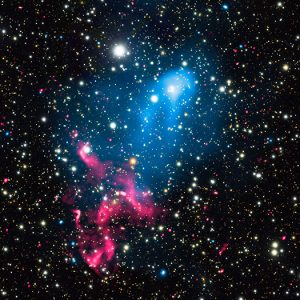Out of this World!
The Smithsonian Astrophysical Observatory (SAO) partners with the Harvard College Observatory for space observation and research. They operate the Chandra X-ray observatory, a telescope designed to detect X-ray emissions from areas of the universe containing extremely hot material such as exploded stars, clusters of galaxies, and matter around black holes.
Recently, Smithsonian fellow Dr. Reinout van Weeren lead a study that discovered a massive particle accelerator created by the combination of a black hole’s magnetic field, and the energy of two galaxy clusters crashing into each other. “We have seen each of these spectacular phenomena separately in many places,” van Weeren said. “This is the first time, however, that we[‘ve] seen them clearly linked together in the same system. This combination created supercharged particles, which are among the most energetic in the universe.
The results of this study were presented to the American Astronomical Society on Thursday, January 5, 2017, in Grapevine, Texas, and have been published in the inaugural issue of the journal Nature Astronomy here. News outlets have picked up the story, which can be found here.







